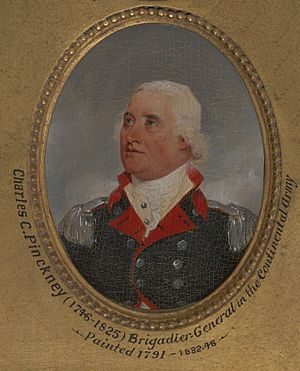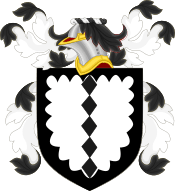Charles Cotesworth Pinckney facts for kids
Quick facts for kids
Charles Cotesworth Pinckney
|
|
|---|---|
 |
|
| United States Minister to France | |
| In office September 9, 1796 – February 5, 1797 |
|
| President | George Washington |
| Preceded by | James Monroe |
| Succeeded by | Robert R. Livingston |
| Personal details | |
| Born | February 25, 1746 Charleston, South Carolina |
| Died | August 16, 1825 (aged 79) Charleston, South Carolina |
| Political party | Federalist Party |
| Spouses |
Sarah Middleton
(m. 1773; Mary Stead
(m. 1786) |
| Children | 3 |
| Education | Christ Church, Oxford Middle Temple |
Charles Cotesworth Pinckney (born February 25, 1746 – died August 16, 1825) was an important American leader. He was a Founding Father, a military officer, and a statesman. He helped create the Constitution of the United States, which he signed.
Pinckney also served as the United States Minister to France from 1796 to 1797. Later, the Federalist Party chose him to run for president twice, in 1804 and 1808, but he did not win either election.
Pinckney came from a powerful family in South Carolina. He became a lawyer and was elected to the colonial government. He strongly supported America becoming independent from Great Britain. During the American Revolutionary War, he was a brave soldier and became a brigadier-general.
After the war, he continued to serve in the South Carolina government. He believed America needed a stronger national government. He was a key person at the 1787 Philadelphia Convention, where the new U.S. Constitution was written. His efforts helped South Carolina agree to the Constitution.
President George Washington offered Pinckney important jobs, but he first declined them. In 1796, he accepted the role of minister to France. This led to a famous event called the XYZ Affair, where French officials asked for a bribe. Pinckney refused and returned home. He then became a general during the Quasi-War with France.
Pinckney joined the Federalist Party after his return. He was nominated for vice president in 1800. Later, he ran for president in 1804 and 1808, but lost to Thomas Jefferson and James Madison.
Contents
Early Life and Education
Charles Cotesworth Pinckney was born in Charleston, South Carolina, on February 25, 1746. His family were wealthy planters. His father, Charles Pinckney, was a chief justice. His mother, Eliza Lucas, was famous for growing indigo. His younger brother, Thomas Pinckney, and cousin, Charles Pinckney, both became governors of South Carolina.
In 1753, Pinckney's family moved to London, England. His father worked there as a representative for the colony. Charles and his brother Thomas went to Westminster School. They stayed there even after their family returned to South Carolina in 1758.
Charles went to Christ Church, Oxford, in 1763. He started studying law at Middle Temple in 1764. He also spent some time at a military school in France. He finished his studies in 1769 and became a lawyer in England. Soon after, he started his own law practice in Charleston.
In 1773, Pinckney married Sarah Middleton. Her father, Henry Middleton, was a president of the Continental Congress. Her brother, Arthur Middleton, signed the Declaration of Independence. Sarah died in 1784. In 1786, Pinckney married Mary Stead. She came from a rich family in Georgia. Pinckney had three daughters.
Early Political Career
After returning to South Carolina, Pinckney became a lawyer in Charleston. He was first elected to the colonial government in 1770. In 1773, he worked as a regional attorney general.
When the war for independence began in 1775, Pinckney supported the American Patriots. He was part of the first South Carolina provincial congress. This group helped South Carolina become an independent state. During the American Revolutionary War, he served in the state legislature. He was also a member of the South Carolina Senate.
Revolutionary War Hero
Pinckney joined the colonial army in 1772. He helped South Carolina get ready to fight British rule. In 1775, he joined George Washington's Continental Army as a full-time officer. He was a captain and led a special group of soldiers called Grenadiers.
In June 1776, he helped defend Charleston in the Battle of Sullivan's Island. British forces tried to attack, but the Americans won. Later in 1776, Pinckney became a colonel and led his regiment until the war ended.
The British then focused on the northern states. Pinckney and his soldiers went north to join General Washington. They fought in the Battle of Brandywine and the Battle of Germantown. During this time, he met future leaders like Alexander Hamilton and James McHenry.
In 1778, Pinckney's regiment returned south. They tried to take British East Florida, but the mission failed. Later that year, the British captured Savannah, Georgia. In 1779, Pinckney helped try to take Savannah back in the Siege of Savannah. This attack was a disaster for the Americans.
Pinckney also helped defend Charleston in 1780, but the city fell. He became a prisoner of war. While captured, he showed great leadership. He kept his soldiers loyal to the American cause. He famously said, "If I had a vein that did not beat with the love of my Country, I myself would open it." He was held until 1782. In 1783, he was made a brigadier general.
Shaping the Constitution
After the war, Pinckney returned to being a lawyer. He became one of the best lawyers in South Carolina. He also returned to the state legislature. He and his brother Thomas became very powerful in the state.
Pinckney believed that a strong national government was needed to protect the states. He represented South Carolina at the Constitutional Convention in 1787. This meeting created the new U.S. Constitution.
Pinckney played a key role in getting the Constitution approved in South Carolina in 1788. He also helped write the South Carolina Constitution in 1790. After this, he said he would retire from politics.
The XYZ Affair

In 1789, President George Washington offered Pinckney important jobs, but he turned them down. In 1796, Pinckney accepted the job of minister to France. At this time, relations between the U.S. and France were very bad. France was angry about a treaty between the U.S. and Great Britain.
When Pinckney arrived in France in November 1796, French officials refused to meet with him. They said no ambassador would be accepted until the problems were solved. Pinckney was very upset by this.
President John Adams sent a new group to France in 1797. This group included Pinckney, John Marshall, and Elbridge Gerry. In Paris, French agents (called X, Y, and Z in later reports) secretly asked for a large loan to France and bribes for French officials. The American leaders found these demands insulting. This event became known as the "XYZ Affair."
Pinckney and Marshall left France in April 1798. The failed talks led to an undeclared naval war called the Quasi-War. Congress then decided to make the U.S. Army bigger. President Adams asked Washington to lead the Army. Washington agreed, but only if Pinckney was also made a general. Washington believed Pinckney's military skills and support in the South were very important. Pinckney accepted his new role without complaint. He led the Army's southern department from 1798 to 1800.
Running for President
Pinckney had tried to stay out of political parties. But after returning from France, he started to identify as a Federalist. With the support of Alexander Hamilton, Pinckney became the Federalist candidate for vice president in the 1800 election. Federalists hoped he could win votes in the South. However, the Federalists lost the election to the Democratic-Republicans.
In the 1804 election, Federalists knew it would be hard to beat the popular President Thomas Jefferson. They nominated Pinckney for president, but he did not campaign actively. Jefferson won by a huge margin. Pinckney lost his home state of South Carolina, which was unusual for a major party candidate.
Jefferson's second term was more difficult. Britain and France attacked American ships. Federalists hoped to win the presidency in 1808. They nominated Pinckney again. They thought his military experience would appeal to the country, especially with a possible war coming. However, James Madison, the Democratic-Republican candidate, won the election.
Later Life and Death
After the 1808 election, Pinckney focused on his plantations and his law practice. He was the president-general of the Society of the Cincinnati from 1805 until his death. He also became a member of the American Antiquarian Society in 1813.
Charles Cotesworth Pinckney died on August 16, 1825. He was buried in St. Michael's Churchyard in Charleston, South Carolina. His tombstone says he was "One of the founders of the American Republic."
Views on Slavery
Pinckney owned enslaved people throughout his life. He believed that slavery was needed for South Carolina's economy. At the Constitutional Convention, he agreed to end the slave trade in 1808. However, he was against freeing enslaved people. In 1801, he owned about 250 enslaved people. When his daughter Eliza got married, he gave her fifty enslaved people. When he died, he left his remaining enslaved people to his daughters and nephews.
In 1788, Pinckney explained why the U.S. Constitution did not have a bill of rights. He noted that bills of rights usually say all people are born free. He said it would be difficult for them to make such a statement when many of their possessions were people who were born enslaved.
Memorials and Legacy
Many places and things are named after Charles Cotesworth Pinckney:
- Castle Pinckney in Charleston Harbor, built around 1810, was named for him.
- Pinckney Island National Wildlife Refuge, a wildlife area, is named after his family's plantation.
- Schools in Fort Jackson, South Carolina, Mount Pleasant, South Carolina, and Lawrence, Kansas, are named C. C. Pinckney Elementary or Charles Pinckney Elementary.
- During World War II, a ship called the SS Charles C. Pinckney was named in his honor.
- Pinckney Street in Boston and Madison, Wisconsin, are named after him.
- Pinckneyville, Illinois, and Pinckney, Michigan, are named after him.
- Pinckney Highway (SC 9) in Chester, South Carolina, is named in his honor.
- A type of plant, Pinckneya, was named for him.
Images for kids
See also
 In Spanish: Charles Cotesworth Pinckney para niños
In Spanish: Charles Cotesworth Pinckney para niños






